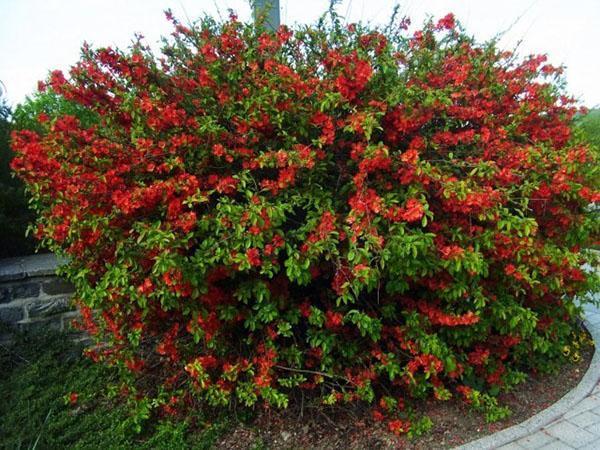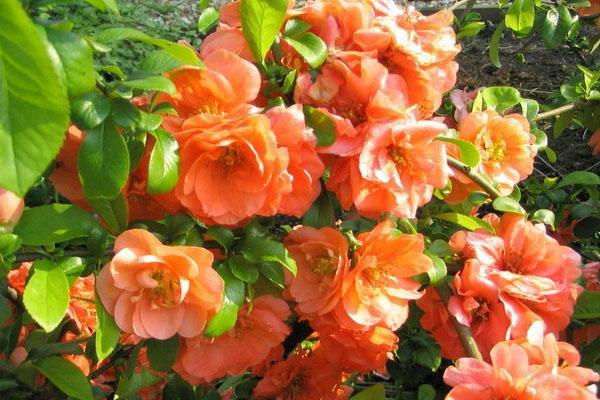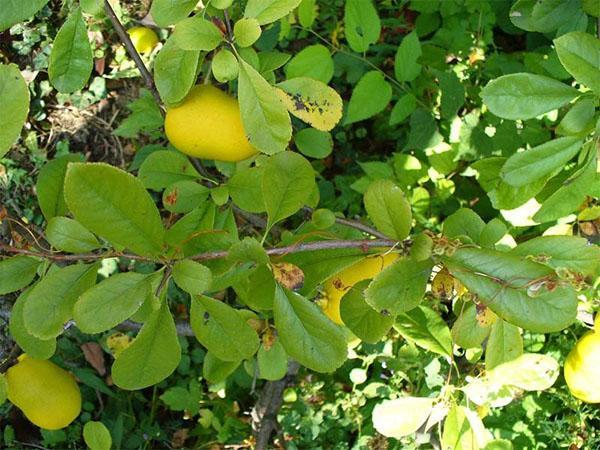Rules for the care and planting of Japanese quince
 In gardens, not only ordinary shrubs and trees are often planted, but also exotic ones, which include japonica... Another name is Chaenomeles. The home of the plant is Japan. It is also found in China and Korea, though only a wild variety. Also, the tree is planted in the gardens of Ukraine and Russia. Quince prefers to grow on plains, mountain slopes (up to 1.4 km above sea level), forest edges, clearings and clearings. It can also be found in swampy areas, along water bodies.
In gardens, not only ordinary shrubs and trees are often planted, but also exotic ones, which include japonica... Another name is Chaenomeles. The home of the plant is Japan. It is also found in China and Korea, though only a wild variety. Also, the tree is planted in the gardens of Ukraine and Russia. Quince prefers to grow on plains, mountain slopes (up to 1.4 km above sea level), forest edges, clearings and clearings. It can also be found in swampy areas, along water bodies.
Japanese quince: photo and description of the bush

- Branches. Being felted-fluffy and painted in a green-gray hue, after a while, as they grow, they acquire a black-brown color. At the same time, their pubescence is lost. Black color of the kidneys. The bark is thin, scaly, dark gray or reddish brown. On the branches on the petioles there are shiny, 5 cm egg-shaped leaves with a blunt-toothed edge.
- The flowers have petals of an obovate orange-red color, the diameter of which reaches 4 cm.
- The fruit is a false apple, shaped like a pear or an apple about 4 cm in circumference, covered with a slightly pubescent skin. As for the pulp, it is hard, sweetish-tart, astringent.

Chemical overview
Quince fruits contain a storehouse of components useful for the body. So, vitamin C in them is about 100-150 mg, in addition to it, vitamins E, B1, PP, A, B2, K, B6, various organic acids (citric, malic, tartronic), fatty acids, proteins, sugars, fructose, tanning substances, ethyl esters, antioxidants, glucose, pectins, minerals such as calcium, boron, iron, phosphorus, copper, zinc, pectins, silicon.
Quince seeds contain: amygdalin glycoside, starch, glycerides of myristic and isoleic acids, mucus, tannins, including tannin.
Growing and care
 There are no problems in growing quince. For proper development and good growth, all requirements must be met.
There are no problems in growing quince. For proper development and good growth, all requirements must be met.
Where to locate
Quince shrubs love good lighting, so you need to choose a lighted area in your area. In principle, the plant grows well in the shade, but you will not expect fruit from it.
Be especially careful when planting and caring for Japanese quince in the Moscow region. Of all the existing varieties, many winter well without insulation. But in very cold winters, annual plants can freeze slightly. It is recommended to plant trees in areas where there is usually a lot of snow. And if severe winters are a regularity, shrubs cover for wintering with spruce branches.
The soil
Chaenomeles thrives on any soil. The favorite are moist clayey and poor sandy ones. But they need to be fertilized with humus and moistened. Saline and limestone soils are categorically unacceptable.
Landing
 For planting, sand, leafy earth and peat are mixed in a ratio of 1: 2: 2. Additionally, fertilizers are applied to the hole: superphosphate (0.2 kg), 1-2 buckets of humus (1-2 buckets), potash nitrate (0.3 kg), ash (0.5 kg).
For planting, sand, leafy earth and peat are mixed in a ratio of 1: 2: 2. Additionally, fertilizers are applied to the hole: superphosphate (0.2 kg), 1-2 buckets of humus (1-2 buckets), potash nitrate (0.3 kg), ash (0.5 kg).
Plant quince shrubs 3-5 in one group.Adult plants are placed at a distance of at least one meter from each other, so that the plants develop well.
Young growth is best transferred to the ground to a permanent place with the arrival of spring, when the ground thaws. It is possible to plant Japanese quince in autumn during the period of strong leaf fall. But this is fraught with the fact that the plant will not have enough time to take root until frost and it will die.
 Position the tree so that the root collar is flush with the soil. If the plant is already an adult, 3-5 years old, for them you need to dig a hole 0.5-0.8 m deep and 0.5 m wide.
Position the tree so that the root collar is flush with the soil. If the plant is already an adult, 3-5 years old, for them you need to dig a hole 0.5-0.8 m deep and 0.5 m wide.
Reproduction
Japanese quince can be propagated in several ways.
Seed
 The ripened fruit is cored and the seeds are taken out. They must be sown immediately into the ground in the fall. Seed germination is excellent.
The ripened fruit is cored and the seeds are taken out. They must be sown immediately into the ground in the fall. Seed germination is excellent.
If it is impossible to sow before winter, the seeds are sent for stratification: they are kept for 2-3 months in wet sand at + 3 + 5 ° C. When they hatch, the seeds are planted in the ground.
Cuttings
 In early June, early in the morning, when it is not very hot and dry, green cuttings are cut so that they have 2 knots. It will be best if you cut the stalk with a "heel" up to 1 cm. Place the cuttings in growth stimulants (for example, a 0.01% indolylbutyric acid solution) for a day. You can use "Kornevin". The prepared material is planted in a substrate (peat and sand, 1: 3) according to the 7 * 5 cm scheme, placing it obliquely.
In early June, early in the morning, when it is not very hot and dry, green cuttings are cut so that they have 2 knots. It will be best if you cut the stalk with a "heel" up to 1 cm. Place the cuttings in growth stimulants (for example, a 0.01% indolylbutyric acid solution) for a day. You can use "Kornevin". The prepared material is planted in a substrate (peat and sand, 1: 3) according to the 7 * 5 cm scheme, placing it obliquely.
Root cuttings
Quince produces a large number of root layers. To get them, you need to dig out the plant and separate the cuttings 0.5 cm thick and 10-15 cm high. At the same time, make sure that the root system is well developed.
From one bush you can "get" no more than 6 divisions.
The resulting shoots are planted vertically and looked after, maintaining the moisture of the substrate and watering. After spend mulching wood chips, humus, shavings.
Diseases and pests
 For the Japanese quince, the most important problem is aphids, at the appearance of which the plant may die. As soon as you notice the first signs of these insects, you should immediately treat with insecticidal preparations.
For the Japanese quince, the most important problem is aphids, at the appearance of which the plant may die. As soon as you notice the first signs of these insects, you should immediately treat with insecticidal preparations.
With the onset of cool and damp weather, accompanied by high humidity, trees can undergo a variety of fungal diseases. For example, it could be:
- cercosporosis, which is detected by the appearance of brown spots that fade over time;
- leaf spot and necrosis, leading to drying out and deformation of the foliage;
- ramulariasis, the signal of which is the formation of brown spots on the leaves.
 Problems can be dealt with by treating the plant with a soap-copper solution and 0.2% foundation. If you are afraid to use chemical preparations or simply do not recognize them, then you can use onion infusion (0.15 kg of onion peel is poured into 10 liters of water and insisted for a day), which should be sprayed several times with the bushes at intervals of 5 days.
Problems can be dealt with by treating the plant with a soap-copper solution and 0.2% foundation. If you are afraid to use chemical preparations or simply do not recognize them, then you can use onion infusion (0.15 kg of onion peel is poured into 10 liters of water and insisted for a day), which should be sprayed several times with the bushes at intervals of 5 days.
Harvesting quince
 Quince is considered a medicinal plant, and not only fruits, but also leaves and seeds are used.
Quince is considered a medicinal plant, and not only fruits, but also leaves and seeds are used.
Newbie gardeners are worried about when to harvest the fruits of the Japanese quince. The fruits are harvested in the fall before the first frost. Then each fruit is well wrapped in paper, placed in a ventilated box and stored in a cool place (6-10 ° C), devoid of light. In this state, even unripe fruits can be stored until February. If there are not enough "apples", they can be placed in a plastic bag and put in the refrigerator. They can be stored there for up to 3 months.
Quince foliage is harvested while the plant is still in bloom. It is laid out on a baking sheet and dried in the shade or in a dryer at a temperature of 40 degrees, transferred to tightly closed containers and used for its intended purpose.
 If you need to collect seeds, then they are pulled out of ripe fruits, dried at 40-50 ° C. Then they are transferred to containers with a well-closing lid and stored for no more than a year.
If you need to collect seeds, then they are pulled out of ripe fruits, dried at 40-50 ° C. Then they are transferred to containers with a well-closing lid and stored for no more than a year.
With proper planting and caring for Japanese quince (chaenomeles), the shrub will not only delight you with a beautiful flowering, and later with a good harvest, but also support your health.